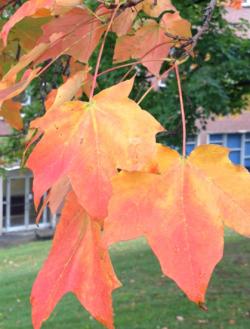Fall Color in New England
 The combination of tree species and climate-type that we experience here in Massachusetts allows us in the Northeast to enjoy what few others in the world (except parts of Asia) enjoy – the fall colors that are part of the hallmark of living in New England.
The combination of tree species and climate-type that we experience here in Massachusetts allows us in the Northeast to enjoy what few others in the world (except parts of Asia) enjoy – the fall colors that are part of the hallmark of living in New England.
As days shorten and nights cool, the flow of nutrients between the succulent leaves of our deciduous woodies and the tree itself begins to progressively slow. Chemical changes occur within the plants leaves, including the increased formation of abscissic acid and a reduction in auxin levels. These changes help to stimulate the formation of an abscission layer – the location where the petiole meets the branch that eventually becomes “walled off” from the rest of the plant, helping to preclude water loss and disease infestation and eventually leading to leaf “fall”. As ethylene levels begin to build, the abscission layer starts to form in earnest and photosynthesis slows significantly. With less and less of the green pigment chlorophyll remaining, we see more and more of the variety of orange and yellow pigments (carotenoids) that were originally “masked” by the green coloration. Some species that are known for their “yellow – orange” appearance include many of the birches (Betula spp.), hickories (Carya spp.), lindens (Tilia spp.), ash (Fraxinus spp.), and beech (Fagus spp.). While we know carotenoids perhaps for their colorful contributions to sweet potatoes, carrots, mums and sunflowers, they also are believed to play an active role in photosynthesis and help to maintain the integrity of chlorophyll when exposed to oxygen and light.
What about the other varieties of color that we see in the fall? Anthocyanins are pigments known to form when concentrations of sugar remain in the leaves as the weather – particularly nights – begins to cool. So, when we experience sunny days and cool fall nights (and especially if we have acidic soils), we can enjoy the reds and purples present in some of our oaks (Quercus spp.), dogwoods (Cornus spp.), maples (Acer spp.) and black-gum (Nyssa sylvatica). So while we may be more familiar with anthocyanins, perhaps for their espoused health benefits (they are in all sorts of purple-red fruits like blackberries, cranberries and cherries) or because they make a rose red, we can’t understate the invaluable contribution they make to leaf color here in the autumn.
And what of those deciduous trees that don’t shed at least some of their leaves? Marcescence is the term used to refer to the occurrence relating to trees “holding” their “deciduous” leaves. We often observe this occurrence with members of the fagaceae (beech family), including American beech (Fagus americana) and some oaks (Quercus spp.). In these instances where we see leaves on some of these specimens throughout the winter, it is believed that the abscission layer simply hasn’t fully formed on the unshed leaves until the commencement of the following growing season.
And until we welcome in our next season (i.e. winter), enjoy those fall colors!